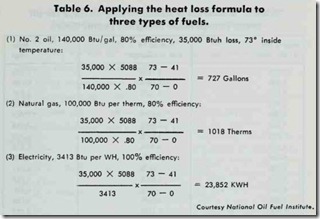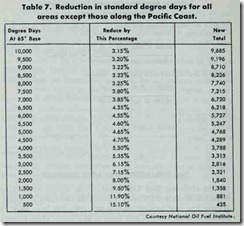The Heat Loss Formula results in higher percentages of total requirements because it does not take into consideration internal heat gains obtained from appliances, sunlight, the body heat of the occupants, electric lights and other sources. The Corrected Heat Loss Formula includes these factors (see the appropriate section of this chapter).
The Heat Loss Formula will include the following data:
1. Heat loss expressed in Btu’s,
2. Total hours in the heating season,
3. Average winter temperature difference,
4. Btu’s per unit of fuel,
5. Efficiency of utilization,
6. Difference between inside and outside design temperatures.
The product of the first three items ( 1-3) is divided by the product of the last three (4-6). In other words, heat loss X total hours X average winter temperature difference -:- by the Btu’s per unit of fuel X efficiency of utilization X inside design tem perature – outside design temperature.
The method for calculating heat loss was described in the last
chapter (see Chapter 3.), and is expressed in Btu’s per square foot per hour per degree Fahrenheit design temperature difference.
The total hours in the heating season will depend on the location of the house or building. If it is located in a southern state, the heating season will be much· shorter than for one lo cated in a colder climate. Assuming that the heating season begins October 1 and ends May 1, the total number of days for which heat may be required is 212. This figure is multiplied by 24 (hours) to obtain the total hours in the heating season (i.e. 5088).
The average winter temperature difference is found by sub tracting the average low temperature from the average high tem perature for the location in which the house or building is situated.
The Btu per unit of fuel is determined for each type, and this information can usually be obtained from the local distributor of the fuel.
Most heating equipment will burn oil or gas at an 80 percent combustion efficiency. Electric energy is generally considered to be used at 100 percent efficiency.
The outside design temperature is the lowest temperature ex
perienced in a locality over a three to four year period. These outside design temperatures are available for a large number of localities throughout the United States. If the house or building is located in a small town or rural area, the nearest known out side design temperature is used. This inside design temperature is the temperature to be maintained on the interior of the house or building. The difference between the two design temperatures is used in the Heat Loss Formula.
Table 6 illustrates the use of the Heat Loss Formula for three
types of fuel/energy:
1. Oil,
2. Natural gas,
3. Electricity.
THE CORRECTED HEAT LOSS FORMULA
The Corrected Heat Loss Formula was devised in 1965 by Warren S. Harris and Calvin H. Fitch of the University of Illinois. It takes into consideration internal heat gains that have shown a marked increase over the past forty to fifty years. These internal heat gains make a significant contribution to the total required heat of a house or building, a factor which makes the original 65°F heat base established some forty odd years ago too low for making a correct estimate. Furthermore, an inside average tem perature of 73°F is probably more correct than the 70°F tem perature previously used.
According to Harris and Fitch, the degree day base (for all areas except along the Pacific Coast) must be corrected by the percentage given in Table 7. The calculated heat loss should then be reduced by 3.5 per cent for each 1000 feet the house or building is located above sea level. If the heat loss is below 1000 Btu’s per degree temperature difference, the 65oF degree day base should be further reduced to the figures given in Table 8.
Table 9 illustrates the use of the Corrected Heat Loss Formula for determining comparative fuel requirements for a No. 2 oil and natural gas.


